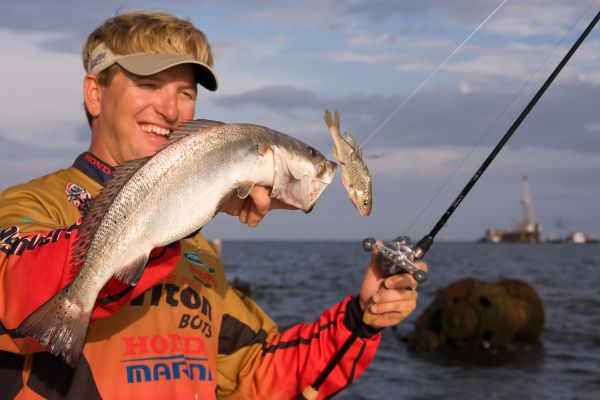Effectively keep live bait in the strike zone, even in deeper water with current
For years, the standard way to present live bait to trout feeding in surf, around rocks or in deeper water has been a plain old bottom rig – also known as a Carolina rig.
With a simple egg weight, a swivel, a leader line and a hook, anglers have a way to keep their live shrimp near the bottom where trout typically feed in those kinds of fishing spots.
To make a Carolina rig, pass your main line – braided line seems to be best – through a 1/2- to 1-ounce egg weight and tie it to a swivel. Tie about a 20- to 30-pound test monofilament or fluorocarbon leader line to the other end of the swivel, and then tie on your hook.
Although a single hook will work, some anglers have started using treble hooks on the ends of their Carolina rigs.
Capt. Craig Matherne out of Grand Isle has been using a Carolina rig for years along the surf and jetties, and he’s determined that it’s an efficient and effective way to catch a quick limit of speckled trout using live shrimp.
Also, Capt. Charlie Thomason has been known to rely heavily on Carolina-rigged live croakers when he finds himself fishing the rigs in Black Bay out of Hopedale.
Whether you use shrimp or croakers, the technique is rather simple: Find some current pulling around a structure and make a cast.
Matherne’s favorite Carolina-rig targets out of Grand Isle are the rock walls and the jetties at Caminada Pass.
“You can fish a Carolina rig right off the rocks,” he said. “But what I really like to do is fish the current lines off the rocks. As the water pulls around the rocks, you can see where it swirls and breaks into open water between the rocks. That’s usually where I catch my trout on Carolina rigs.”
Matherne also pointed out that the Caminada Pass jetties are a perfect example of a spot where a cork would work on one side, whereas a Carolina rig would work better on the other.
“The beach side of those rocks is shallow and better suited for a cork,” he said. “But move to the pass side, and you’re probably going to be better off throwing a Carolina rig in that deeper water. That’s why you want a big egg weight – to keep it down on the bottom in all that current.”
Thomason, on the other hand, prefers fishing Carolina-rigged croakers in deep water on the rigs. Other than having to use a little bit heavier egg sinker, the only difference is the type of structure.
“I like to set up on a corner of a rig that has tide pulling around it,” Thomason said. “I want to be able to cast up current or at least kind of to the side. A big weight will get it to the bottom. Then all I do is keep my line tight as the current moves my rig along. Maybe I’ll pull the weight every now and then just to keep it moving slowly if I need to.”
The only two drawbacks of a Carolina rig with live bait are that live bait will look for a place to hide, and the bait will be close enough to the bottom that you’ll periodically have to deal with croakers and hard-head catfish.
But that’s not too bad of a price to pay to be able to fish a rig that’s going to consistently keep your bait in the strike zone.
Editor’s Note: This is the final article in a weeklong series by Chris Ginn on effective speckled trout fishing techniques to try this month. Yesterday he highlighted the sliding cork, and earlier in the week he covered the drop-shot rig, the popping cork and the double-rig.



